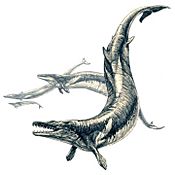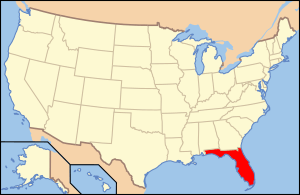Paleontology in Florida facts for kids
Paleontology in Florida is all about studying fossils found in the state of Florida. It also includes research done by people from Florida. Florida has an amazing collection of fossils. These fossils tell us about life from the Eocene period all the way to recent times. Many Florida fossils are very well preserved.
The oldest fossils found in Florida are from the Eocene period. Back then, Florida was covered by a sea. This sea was home to many ocean creatures. It also had early whales, like Basilosaurus. Later, during the Miocene period, Florida became dry land again. This happened because of land rising and mountain building. But in the Florida Keys, coral reefs were growing.
During the Pliocene period, Florida's oceans had dugongs, porpoises, sharks, and whales. On land, there were camels, dogs, horses, and relatives of modern elephants. Saber toothed cats and tapirs also lived in the state. The Pleistocene epoch has the most fossils in Florida. In fact, Florida is known as the best place in the world to find Pleistocene mammals. These included short-faced bears, saber-toothed cats, glyptodonts, mammoths, mastodons, giant ground sloths, and wolves.
Contents
Florida's Ancient Past: A Fossil Journey

Florida has a very rich fossil record. Its geologic history is also quite complex. The land under Florida was once part of a huge ancient continent called Gondwana. It joined North America when an even bigger continent, Pangaea, formed during the Permian period.
During the Mesozoic Era, Pangaea began to break apart. Florida stayed connected to North America. Even though dinosaurs likely lived here, no dinosaur fossils have been found in Florida. In fact, no fossils older than the Eocene period are found on the surface. However, the geologic record helps scientists understand Florida's changing environment during the Mesozoic. During the Cretaceous period, Florida was much wider. This was because parts of the continental shelf were above water. Later in the Cretaceous, rising seas covered northern Florida. This connected the Gulf of Mexico to the Atlantic Ocean. This water passage was called the Suwannee Straits.
Life in Florida's Ancient Seas
A shallow sea covered most of Florida during the Paleogene period. Clams, echinoderms, and gastropods lived in this sea. The Cenozoic limestone that formed in these seas is common in Florida. It is also full of fossils. The oldest fossil-rich rock layers in Florida are from the Eocene period. During the Eocene, early whales like Basilosaurus swam over Florida. Many shelled creatures, sharks, and sirenians (like manatees) also lived there.
Animals of the Oligocene and Miocene
Oligocene fossils in Florida show that many different land animals lived here. During the early Miocene period, land rising and mountain building filled in the Suwannee Strait. At this time, coral reefs were growing in the Florida Keys. The Thomas Farm Quarry is the best place in the eastern US to find Miocene mammal fossils.
Pliocene Creatures of Bone Valley
During the Pliocene period, Florida was home to many creatures. These included amphibians, bears, and many kinds of birds. There were also camelids, crocodilians, deer, and dogs. Dugongs, at least six types of horses, and peccaries also lived here. Other animals included porpoises, relatives of modern elephants, rays, saber toothed cats, seals, sharks, tapirs, turtles, and whales. The remains of all these animals have been found in a place called Bone Valley in Polk County.
Late Tertiary (a time period before the Pliocene) vertebrate fossils are found in southern Florida. When these animals were alive, the southern 300 kilometers of Florida was still underwater. Late Tertiary sediments in Gilchrist County have preserved badgers, Kodiak bears, camels, dogs, horses, and rhinos. Mammoths, mastodons, sloths, giant beavers, and ungulates (hoofed animals) were found near Gainesville.
Giants of the Pleistocene Epoch
The Pleistocene limestones of the Florida Keys are full of fossils. The Pleistocene is the time period best shown in Florida's fossil record. In fact, Florida's Pleistocene sediments are considered the best in the world for fossils. This is especially true for the mammals from that age. Also, Pleistocene Florida had more different kinds of land animals than any other place or time in North American history.
During this time, the local sea level went up and down. This was linked to how much water was trapped in the glaciers in the northern part of the continent. When the sea pulled back, savannas (grasslands) formed. Herds of American mastodons and Columbian mammoths ate the local plants. The huge ground sloth Eremotherium was another large plant-eater. Other herbivores included antelopes, bison, deer, armored glyptodonts, and the modern horse. These animals were hunted by predators like short-faced bears, jaguars, saber-toothed cats, lions, dire wolves, and wolves.
Discovering Florida's Fossil History
In 1931, a farmer found some bones while plowing his field. He thought he had found an old Native American burial site. But the bones turned out to be fossils! The University of Florida bought them. The ancient creatures whose remains were found included a large dog-like bear, two different kinds of camels, several different species of horse, and a pig-like animal.
In 1963, several new Miocene fossil sites were discovered. One was found in the far northern part of the state, near its border with Georgia. Another was found near Ocala. A third discovery happened in Hernando County. The Hernando County site preserved the remains of animals like alligators, members of the dog family, oreodonts, rhinoceroses, and tapirs.
Places to Explore Fossils
Protected Fossil Areas
Famous Paleontologists
- Walter Auffenberg died in Gainesville on January 17, 2004 at age 75.
- Pierce Brodkorb died in Gainesville on July 18, 1992.
- Cesare Emiliani died in Palm Beach Gardens on July 20, 1995.
Natural History Museums in Florida
- Florida Museum of Natural History, Gainesville
- Bishop Museum, Bradenton
- Mulberry Phosphate Museum, Mulberry
- Orlando Science Center, Orlando
- Palm Beach Museum of Natural History, Wellington
- Paleo Preserve Fossil Museum, Ruskin
Fossil Clubs and Groups
- Bone Valley Fossil Society
- Florida Fossil Hunters
- Florida Paleontological Society
- Fossil Club of Miami
- Southwest Florida Fossil Club
- Tampa Bay Fossil Club
Fossil Events
- Fossil Fair


